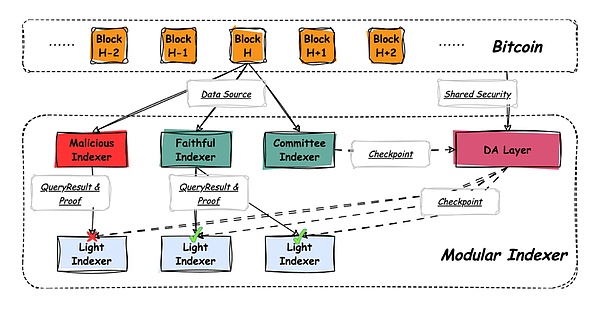Author: Cook Sun Crypto Chef, Source: Author Twitter @Cook0x
1. The birth of the indexer
Before the introduction of Inscriptions and Ordinal protocols, due to the Turing incompleteness of its scripting language, Bitcoin was in application Limited in scope. Fortunately, with recent advances in technology, a Turing-complete off-chain execution layer has been established through the Bitcoin Indexer. However, the data integrity and availability of existing indexers rely heavily on the indexer's honesty.
Specifically, for an off-chain execution layer, the indexer may tamper with the data, causing users to obtain incorrect status. This is the issue of indexer centralization that has been discussed in the Bitcoin ecosystem for a long time. Currently, there is no perfect solution between centralization and decentralization.
2. What are the problems with direct decentralization?
If a decentralized indexer network is utilized to perform calculations, then, since the network is completely permissionless, the consensus mechanism of the existing decentralized indexer network is vulnerable to Sybil attacks, which makes malicious indexer operations Vendors are able to provide users with incorrect status, such as asset ownership and available balance. This is the establishment of a new consensus layer, which requires a strong consensus network and cannot be achieved in a short time.
3. Modular indexer
If you want to solve The key point of this problem is to design a mechanism that enables users to efficiently and economically verify the validity of the state provided by the indexer. The solution proposed by Nubit is not to perform integrity checking of the entire state transition, but to simplify it to check the validity of a small number of checkpoints. The goal is to achieve data integrity and availability as long as one committee indexer is doing correct verification even if most of the committee indexers are attacked or do evil.
4. Nubit architecture
The architecture relies on Bitcoin as the most basic trusted data layer
The committee indexer calculates the protocol status based on the Bitcoin block, generates a checkpoint (polynomialcommitment), and publishes it to NubitDA (data availability layer).
Nubit DA is responsible for publishing data and ensuring that checkpoint data is available
The indexer is responsible for providing query results and corresponding proofs to users.
The lightweight indexer is run by the user, and the necessary parts of the protocol status can be queried from the indexer, using checkpoints to verify the results. Correctness. If checkpoints provided by multiple committee indexers are inconsistent, stateless computation can be leveraged to generate the correct checkpoint.

Stateless computation
Stateless computation is a technology that allows users to download data without downloading and where the entire protocol state is stored, verify that the execution results provided by the indexer are correct.
The traditional verification method requires the user to download all the status data and then re-execute the entire calculation process, and Compare the results of the indexer to verify the correctness of the results. This practice requires significant storage and computing resources.
The starting point of stateless computing technology is: even if the user does not have all the state data, as long as there is a small amount of key state data (such as the previous Checkpoint state), you can effectively verify the correctness of subsequent states without repeating the entire calculation process.
It uses cryptography technology (such as polynomialcommitment, etc.) to compress all state data into a small encrypted checkpoint. The user only needs Downloading and verifying this checkpoint is equivalent to verifying the accuracy of the entire status data.
When the checkpoints provided by multiple committee indexers are inconsistent, the user can utilize the previous checkpoint state as key input, using Stateless computation regenerates the current correct checkpoint, thereby identifying honest indexers.
Through this stateless computing technology, users do not need to download and store the entire huge state data, only small checkpoints are needed Data can be used to efficiently verify the correctness of the indexer execution results, thereby achieving lightweight verifiable calculations.
5. Summary
Nubit provides an intermediate option between centralized indexers and decentralized indexers, that is, by building a third-party Nubit DA layer to manage data and verify data, but ultimately still relies on Bitcoin as the most basic Trusted data layer, which provides a relatively decentralized solution without sacrificing too much security.
At the same time, Nubit recently announced its cooperation with BounceBit, combining BounceBit's BTC-restaking technology with Nubit's Bitcoin native data availability solution. The first implementation scenario for this solution was immediately implemented.
 ZeZheng
ZeZheng
 ZeZheng
ZeZheng ZeZheng
ZeZheng JinseFinance
JinseFinance JinseFinance
JinseFinance JinseFinance
JinseFinance JinseFinance
JinseFinance Olive
Olive Cheng Yuan
Cheng Yuan Coinlive
Coinlive  Bitcoinist
Bitcoinist